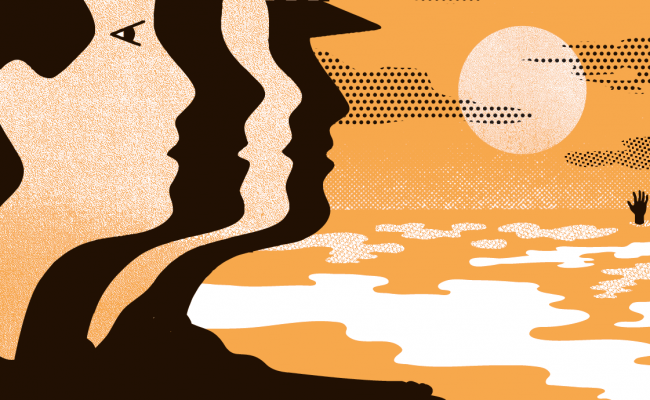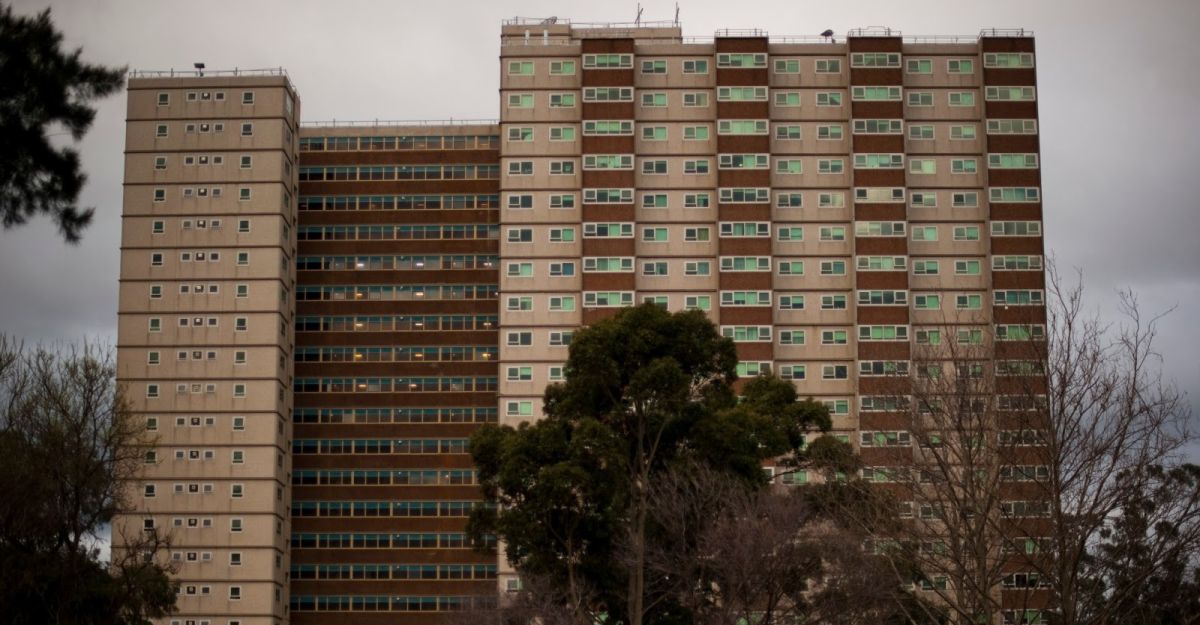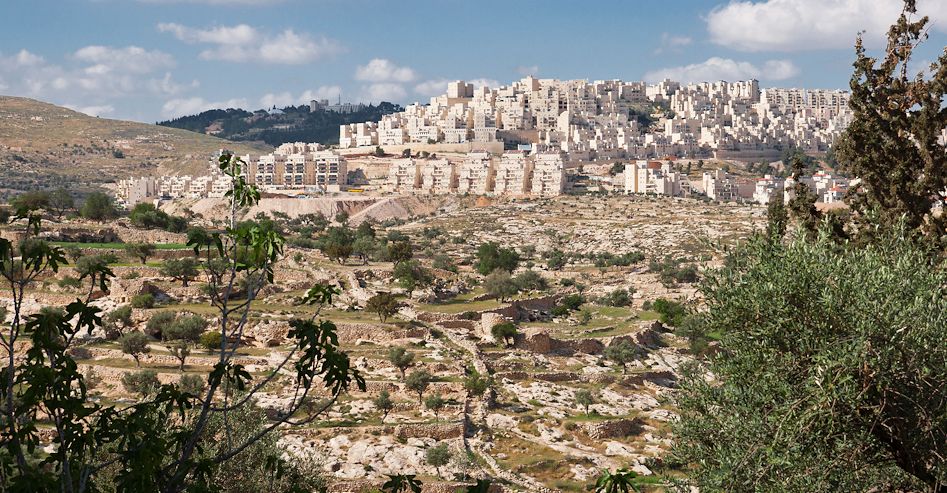Prison islands feature heavily in Australia’s post-invasion history. From the imprisonment of convicts on the islands of Sydney Harbour to the forced removal of Indigenous people to Rottnest Island and Flinders Island, Australian governments have a long tradition of punishing deviance – be it criminal, racial or both – offshore. Those deemed guilty of ‘wrongdoing’ have been kept out of sight and away from scrutiny – a tradition that lives on in the inhumane detention centres of Christmas Island, Manus Island and Nauru.
What many Australians don’t know is that this is not the first time Manus has served this function. Between 1949 and 1953, Japanese war criminals were detained and tried on the island – these were, in fact, the last trials of the Pacific War. Australia’s handling of the situation set as an eerie precedent for its treatment of refugees today. Then, as now, legal manoeuvring and regional dominance were used to subvert judicial processes, dodge international obligations and deny people their basic rights.
Lying to the north of the Papua New Guinean mainland, Manus is the largest of the Admiralty Islands. It has been the subject of various colonial and imperial projects since it was first charted by Europeans in 1528. From 1880 to the First World War, the island was part of German New Guinea, after which it became a mandate territory under Australian administration. Soon after, it changed hands between Japan and the United States, both of whom had claimed the island at various stages of the Second World War. At the end of the conflict, sovereignty reverted to Australia.
While the Australian war courts were allowed by law (the Nuremburg trials had set an international precedent), their execution of justice was legally questionable. Critiques, both then and now, regarded the proceedings as something more akin to victor’s justice than due legal process. Even the right to a speedy trial had been ignored by the Australian authorities: when the Manus trials concluded in 1951, it had already been three years since the final execution of a Japanese soldier by the US. Some prisoners, including some who were found to be innocent, had been awaiting trial after being captured as long ago as 1942.
When Menzies took power in 1949, Australia was already facing criticism for its failure to deal with its remaining Japanese prisoners. By this time the US was focused on recruiting Japan to the fight against communism and had become so frustrated by Australia’s slow progress that a top aide to General MacArthur reportedly asked, ‘[How] can we sell democratic justice to the Japanese if Australia flouts all the rules of the game for more than four years?’ Menzies himself acknowledged the seriousness of the delay, telling parliament that the continuing incarceration of Japanese soldiers ‘violated the fundamental concepts of British justice and therefore required urgent speed’.
Spurred on by increasing local and international pressure, Australia began – with British and American assistance – a series of trials in far-flung locales, including Darwin, Morotai (Indonesia), Labuan (Malaysia), Singapore, Hong Kong and three locations in Papua New Guinea: Manus, Rabaul and Wewak.
The Manus war court sat from May 1950 until April 1951. Twenty-six trials in were held, with ninety-one suspects facing 113 charges, making it the second largest of the Australian war courts (Rabaul being the largest). The defendants ranged from high-ranking officers to the rank and file; all were charged with murder, except for two who were charged with mutilation of the dead, rendering them Class B (violations of the laws and customs of war) and Class C (crimes against humanity) criminals. Of those trialled, sixty-nine were found guilty of one or more charges – five were sentenced to death – and forty-three were acquitted. While the numbers might appear straightforward, they belie the complex web of interests underpinning the trials and the dubious legal processes used to bring convictions.
The decision to host the trials on Manus was driven by complex geopolitical factors. Manus was, at the time, the furthest point of Australian sovereignty from Canberra, and as Dean Aszkielowicz suggests in his PhD thesis, holding the final set of trials there helped Australia assert its dominance over the region. Indeed, the trials signalled Australia’s right to execute its own form of justice in the Pacific theatre. It also represented a rebellion against US authority, as Australia and the US had already had a diplomatic flare-up over Manus before the venue was finalised. The US had decided to decommission its military base on the island, expecting Australia to purchase it, but according to RJ Booker, manager of the store on Manus and quoted in the Sydney Morning Herald, Australia had refused the terms of the sale offered by the US, expecting to receive the base for nothing. The decision to abandon the American base and rebuild an Australian one not only created a military void in the region, but also left Australia with a large write-off of ex-military junk in its territory (an order was made by the US for all existing materials had to be destroyed or sold on, with much of it purchased and removed by China). The US withdrawal fuelled anxieties over possible attacks and the spread of communism, and the Australian authorities recognised the need for a strong symbolic gesture – such as war trials in overseas territories – that would ease local fears while also demonstrating regional hegemony.
‘Pig Iron Bob’ had his own reasons for seeking a quick conclusion to the trials: he wanted to oversee the reincorporation of Japan into the regional and domestic economy. Australia was beginning to regard Japan as a significant trade ally, as it had been prior to the First World War, and as a much-needed bulwark against communism. Although there were many reasons for Australia to move quickly to re-establish relations with Japan, there was also public pressure for retributive justice to be meted out. Hostility against the Japanese remained strong – this was a time when newspaper headlines could still use the word ‘Japs’ without anyone batting an eyelid.
While the Manus trials satisfied the desire for regional assertion, they were a significant drain on resources. By this time, the government had turned its attention to demobbing the armed forces and domestic matters (such as infrastructure reconstruction and development). Transporting and accommodating witnesses, prisoners, military personnel and auxiliary staff presented a logistical challenge and financial burden. The twenty-six trials on Manus were reported to have cost £100,000 (about $16 million today). The delay in holding the trials also deprived the organisers of British assistance. Experienced British personnel stationed in Singapore and Hong Kong had initially offered their support, but the UK government’s focus had moved on by 1950. The US government was also unwilling to assist by this time.
According to historian Narrelle Morris, four criteria were used to select the cases brought to trial: they involved the deaths of Australian service personnel, required minimal pre-trial preparation, had a high probability of conviction and called for the death sentence.
This selective approach was no accident: this was the first time Australian justice had been carried out overseas against foreign nationals, so some pride was at stake – those who had been held for so long had to be shown to be criminals. This motivation was so powerful that the military ended up getting ahead of itself: an executioner was appointed at Manus well in advance of the trials. Once this had become public knowledge, through a mismanaged memo, the appointment was hastily withdrawn.
From a jurisprudential perspective, the War Crimes Act, which mandated how the trials were to be managed, was less than ideal. The Act authorised the courts to try those accused of committing war crimes against Australians, British subjects or citizens of Allied powers. Crimes against the citizens of South-East Asian nations were overlooked, as were offences against German citizens still living in what was previously German New Guinea. The sentencing range prescribed in the Act was also significantly harsher than on mainland Australia, highlighting the moral and legal ambiguity at the heart of the trials, as the death sentence could be meted out for crimes that would not attract in the same sentence back in Australia.
The War Crimes Act also compromised key legal principles, most notably the accepted conventions of evidence: ‘any oral statement or document appearing on the face of it to be authentic, provided the statement of document appears to the Court to be of assistance,’ could be admitted (emphasis added). Additionally, according to a court transcript, the Director of Prisoners of War and Internees had instructed that the ‘the production of live witnesses by the defence should not be encouraged’. This meant that witnesses who might ordinarily have been cross-examined were not called upon if their statements were on hand, leaving evidence untested.
As such, the majority of convictions were based on documentary evidence alone, something unthinkable in mainland Australia’s legal system, opening up space for contesting charges. For example, Naval Captain Ichikawa Yoshimori argued that ‘certain passages’ had been inserted into the English translation of his statement after he had signed it. Yoshimori was acquitted, after no evidence could be found that proved due process. Many others also avoided conviction on the grounds that cases had been mishandled and/or prisoners intimidated during the taking of testimonies.
The language barrier proved to be another serious problem. Irony and colloquialisms were frequently used by Australian lawyers, making it difficult for the defence to follow proceedings. In one trial, the prosecutor suggested that ‘swords were lying about like baseball bats’, a statement that was translated literally, to the bewilderment of those on trial. Language usage was at the heart of the trial of Lieutenant-General Nishimura, who was accused of ordering the Parit Sulong massacre. The outcome hinged on the phrase ‘shobun seyo’, meaning ‘dispose of’. Nishimura argued that the intended meaning of this order was for the Australian captives to be evacuated, not executed (in which case he would have given the order ‘shokei’). Nishimura was found guilty and sentenced to death by hanging, even though questions remained over interpretation and the lack of supporting evidence. As this was a military court, there was no independent judicial body for Nishimura to appeal to (the military courts did not have an appellate mechanism).
Many trials proceeded without controversy: the courts ruled that war crimes had indeed been committed and dealt with them in line with the War Crimes Act. Tsuaki Takahiko, for example, oversaw the murder of surrendered Australian soldiers near Laha airfield on Ambon Island (Indonesia) on or around 14 February 1942. The killings were largely regarded as an act of revenge, and Takahiko was sentenced to death by hanging for his role in the massacre.
The Australian media’s coverage of the war trials varied in quality. George Dickinson, in analysing reportage of the trials at the time, writes that ‘a Commander Fukumi was described as supervising an execution, with a bottle of whisky in one hand and a sword in the other hand. There was no evidence of this, and in any case Fukumi was not on trial. He had been killed in action in 1942.’ In December 1949, the Sydney Morning Herald claimed the Japanese prisoners had received taxpayer-funded radios and were living a life of leisure, spending their days fishing and farming. This coverage fanned public outrage, with many Australians believing the prisoners were getting an easy ride. In reality, the prisoners had been put to work reclaiming the abandoned American base from the jungle. While much of the military equipment had been destroyed, there was still work to be done – by 1950, there was an estimated 20,000 tonnes of junk still to be worked through. A report in the Herald on 26 July quoted a service officer saying the prisoners had ‘more than paid for their keep’ in reclaiming the disused base and rebuilding Momote airfield. The service officer admitted that this work would have been difficult for a peacetime work force, due to the difficulty of attracting Australians to work, live and serve the military in the distant colony.
Due to a lack of evidence, a considerable number of soldiers acquitted were never called to trial. Deprived of liberty for up to a decade and set to work for Australian military purposes, they became bargaining chips in larger geopolitical disputes, even as they were a source of free labour on Manus. In this post-war period, at the height of the White Australia policy, discrimination against the Japanese (along with other Asian and non-white ethnicities) was widespread and institutionalised. Japanese-Australian war brides, for instance, faced deportation at the end of their five-year temporary visas and regularly experienced social exclusion.
For the term of the trials, purpose-built compounds were constructed by the Australian military for the accused to live in, but the guarding of the prisoners was outsourced to Manus locals, specifically those islanders who had served as policemen and soldiers during prior colonial periods. This made Australia the only Allied country in the post-war period to utilise civilian police as guards for accused war criminals, let alone to draw principally upon indigenous personnel of a colony state.
While Australia’s distrust of islanders was an enduring feature of both wars, hiring locals had a big advantage. The labour was cheap and it saved the cost involved in bringing Australians over, especially as the army was long demobbed. This outsourcing of labour is not dissimilar to today’s situation. Writing in 2015 for the Monthly, Jo Chandler reported that local guards on Manus are currently paid K4 ($1.90) an hour, a pay rate far below that of the fly-in-fly-out guards from Australia. During the trials, many Manus locals were tried for treason, accused by Australia of having collaborated with the enemy – Japan – but there was room at the table for those who had ‘proved themselves’ within the racial and disciplinary hierarchy of the military. The imperial attitude of the time can be found in the advice of EF Robson, the former administrator of the island, who stated that ‘a fine type of native’ was found in ‘the old police boy… a well-disciplined and an energetic man, very proud of the uniform he wears’. In an account narrated by Morris, a Japanese prisoner testified that several ‘native guards’ had ‘appeared at the working area armed with weapons to beat prisoners, with an Australian officer [coming] along now and again to see what was going on and would order the guards to make it more severe’. In response, the prisoner said, the ‘natives beat us even more fiercely’. This, too, has modern parallels; Chandler writes of a ‘notorious riot squad’ being flown in from elsewhere in PNG to secure Australian operations.
The Second World War wasn’t the first time that indigenous Papua New Guineans had been caught up in – and paid a high price for – an international conflict. Australia’s first battle in the First World War was in German New Guinea. It was also here that Australia recorded its first fatalities of the conflict: six soldiers died in the August 1914 battle. While only two Germans were killed, over thirty indigenous police officers died defending the equipment.
The American wartime occupation had an immense impact on the local population. The egalitarian, racially diverse American forces were viewed in a more positive light than the stuffy, racist Australian pre-war regime. In the immediate post-war period, a movement for a democratic, liberated and progressive Christian future sprang up under the leadership of Paliau Maloat. Maloat had been inspired by the generosity, spirit and expertise of Black American troops. Their involvement in construction work and infrastructure development was seen as a model for independence and self-sufficiency, to the extent that a petition was made to the UN for the administration of Manus to be taken over by the US.
After the trials, prisoners were held on Manus until 1953, when they were repatriated to Japan’s Sugamo Prison to complete their sentences. The final release of those eligible for parole came in 1957, two days before Australia bestowed ‘favourable nation’ status upon Japan under the General Agreement on Trade and Tariffs, clearing the way for bilateral trade negotiations. The last surviving prisoner was granted an unconditional pardon in December 1958.
Looking back over the Australia’s involvement with and use of Manus, one can’t help but see parallels with the current treatment of refugees. Manus served as a trialling ground for the execution of prejudiced, though legally permitted, forms of punishment against people unlawfully detained, with information flows controlled by parliament and the military. All of this took place on an island whose population was largely unrecognised, used and ignored.
In 1949, following criticism over Australia’s refusal to purchase the American base, Herbert Evatt stated that ‘Australia has never refused the United States the use of Manus.’ The frankness of the language betrays the intention: Manus was a possession to be used at will. At that time, it was as a tool of sovereignty; today, it’s a tool for keeping international law at bay.
Ultimately, there were no consequences for Australia’s judicial mishandlings of the war trials or the lack of haste in executing justice. Jeremy Bentham writes that the purpose of a prison is not for the rehabilitation of those inside, but for the benefit of those who witness the imprisonment; if the illusion of punishment is to be successful, the punishment given must be that which is desired by those watching. The lessons learnt from the Manus war trials were many: Australia could satisfy domestic interests, escape serious censure from its allies and strengthen its position in the Pacific, all while using the bodies of foreign nationals as bargaining chips in a perverted and heavily weighted judicial situation. Even as the PNG-led closure of Manus looms over a nearing horizon, we remain stuck with one final question: how has this thinking changed?
Artwork by Brent Stegeman.



